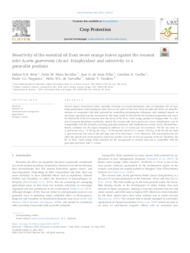Bioactivity of the essential oil from sweet orange leaves against the coconut mite Aceria guerreronis (Acari: Eriophyidae) and selectivity to a generalist predator.
Bioactivity of the essential oil from sweet orange leaves against the coconut mite Aceria guerreronis (Acari: Eriophyidae) and selectivity to a generalist predator.
Autoria: BRITO, D. R. B.; PINTO ZEVALLOS, D. M.; SENA FILHO, J. G. de; COELHO, C. R.; NOGUEIRA, P. C. L.; CARVALHO, H. W. L. de; TEODORO, A. V.
Resumo: Several species of predatory mites, naturally occurring in coconut plantations, play an important role in regulating populations of phytophagous mites that are key pests of this crop. Plant essential oils (EOs) are bioactive mixtures of compounds that hold potential for controlling phytophagous arthropods with minimal impacts on non-target organisms and the environment. This study aimed to characterize the chemical composition and assess the bioactivity of the EO extracted from the leaves of the ?Pera? sweet orange grafted on ?Rangpur lime? to a key pest of coconut plantations worldwide, namely the coconut mite Aceria guerreronis (Acari: Eriophyidae), and its compatibility with the naturally-occurring generalist predatory mite Typhlodromus ornatus (Acari: Phytoseiidae). Briefly, sabinene was the major component, followed by δ-3-carene and (E)-β-ocimene. The EO was toxic to A. guerreronis (LC50 = 4.28 mg/mL; LC80 = 10.39 mg/mL) but not to T. ornatus. The LC80 of the EO did not repel A. guerreronis and was toxic to the pest mite only in the first hours (<9 h). Moreover, this concentration did not affect the growth rate of the predator, which was positive over the 10 days of exposure to the oil. Therefore, the EO of ?Pera? sweet orange holds potential for the management of coconut mite and is compatible with the generalist predatory mite T. ornatus.
Ano de publicação: 2021
Tipo de publicação: Artigo de periódico
Unidade: Embrapa Tabuleiros Costeiros
Palavras-chave: Coco, Coconuts, Essential oils, Laranja Doce, Oranges, Plant diseases and disorders, Praga de Planta, Óleo Essencial
Conteúdo relacionado
Observações
1 - Por padrão são exibidas publicações dos últimos 20 anos. Para encontrar publicações mais antigas, configure o filtro ano de publicação, colocando o ano a partir do qual você deseja encontrar publicações. O filtro está na coluna da esquerda na busca acima.
2 - Para ler algumas publicações da Embrapa (apenas as que estão em formato ePub), é necessário ter, no celular ou computador, um desses softwares gratuitos. Sistemas Android: Google Play Livros; IOS: iBooks; Windows e Linux: software Calibre.
Acesse outras publicações
Acesse a Base de Dados da Pesquisa Agropecuária (BDPA) para consultar o acervo completo das bibliotecas da Embrapa.

